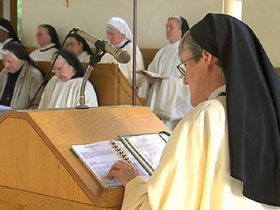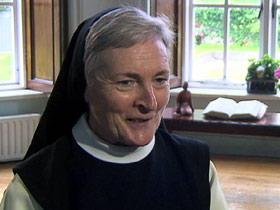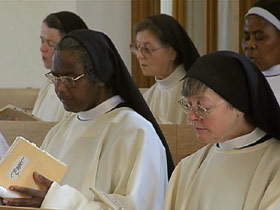In This Episode << SLIDE LEFT TO SEE ADDITIONAL SEGMENTS
St. Mary’s Abbey
DEBORAH POTTER: The bells of St. Mary’s set the rhythm of life at this abbey in Glencairn, sounding the call to worship. On this day, Sister Michelle rings double bells for the Feast of the Ascension.
SISTER MICHELLE MILLER: It has a knack to do it, and about one or two of us have the knack, so that’s where I am. I was ringing the double bells yesterday. From a young age I had a yearning to be a nun, in my teens, so it was part of my journey in seeking a life where I felt I could be as close to seek God as possible.
POTTER: Life here is all about seeking God. This is Ireland’s only Cistercian monastery for women, founded in 1932.
MOTHER MARIE FAHY (Abbess, St. Mary’s Abbey): It’s a place where God is loved and worshiped, and it’s a place where we pray for humanity. We’re conscious of interceding before God for people, and it’s a place of conversion, where we constantly try to become who we are meant to be as fully human persons and overcome the demons and the less positive aspects of our life.
 POTTER: In some ways, life here is the same as it’s always been, governed by the Rule of St. Benedict. Seven times a day, the nuns gather for prayer, starting well before dawn. They spend hours in church and in lectio divina, reading the Bible and other sacred texts.
POTTER: In some ways, life here is the same as it’s always been, governed by the Rule of St. Benedict. Seven times a day, the nuns gather for prayer, starting well before dawn. They spend hours in church and in lectio divina, reading the Bible and other sacred texts.
SISTER MICHELLE: The first word in the rule is “listen.” So in that sense you learn to listen to how God is speaking to you, and to the Holy Spirit in daily life, and how you gradually more attune yourself to his grace. And it takes a lifetime to sustain that, and in that sense you learn to love, and love your sisters as they are, where they are. And it’s a sense of freedom.
POTTER: Most of the day is spent in silence. It’s peaceful most of the time. The abbey is also a working farm with eighty head of cattle.
SISTER LILLY: Takes energy to keep up!
POTTER: For four hours a day every nun works, as they always have. It’s what they work at that’s changed.
NUNS AT COMPUTER: They just added that blue part on top of the head. Ah, yeah, that’s an extra job.
POTTER: Computers and automation have come to the convent. In addition to a small greeting card business, a bakery produces Eucharist bread that’s sold to churches across Ireland. The oldest nuns help with the shipping.
 MOTHER MARIE FAHY: We live by the work of our hands and also have some left for helping out those who are maybe less fortunate. Work is creative. Part of you needs to have some kind of creative expression; you can’t spend all the time praying and reading. It’s very important to have a balance.
MOTHER MARIE FAHY: We live by the work of our hands and also have some left for helping out those who are maybe less fortunate. Work is creative. Part of you needs to have some kind of creative expression; you can’t spend all the time praying and reading. It’s very important to have a balance.
POTTER: The balance of life here is partly what drew Sister Fiachra, who used to run a garden center.
SISTER FIACHRA NUTTY: You know what they say about weeds? They’re like the poor, they’re always with us.
POTTER: She entered the convent five years ago and expects to make her solemn profession next year, committing to live the rest of her life as a cloistered nun.
SISTER FIACHRA: I felt I needed space to be with God, and that’s not very easy, I’ve found, for me in the outside world, because I am quite an extrovert, and I get involved in an awful lot of things, so enclosure was important to me, but at the same time I have a horror of restriction, as in claustrophobia. So here we are absolutely truly blessed. We have 200 acres within which to wander, you know, so that was a huge factor for me. Also the enormous welcome and warmth I felt from the community on my very first visit. That was just so wonderful.
MOTHER MARIE FAHY: We’re not completely silent. We value communication, and communication is important to maintain good relationships.
 POTTER: Thirty-seven women now live at the abbey, and unlike in the past when all would have been Irish, today there are sisters from India, Nigeria, and the Philippines. They’re also older. A third are well above retirement age. The oldest is 93. In the past decade, a dozen nuns have died. Like most monastic communities, St. Mary’s is smaller than it used to be. But six women are in formation, on the path to becoming nuns—far more than might be expected. Only nine women entered religious orders in all of Ireland in 2006, according to the most recent survey.
POTTER: Thirty-seven women now live at the abbey, and unlike in the past when all would have been Irish, today there are sisters from India, Nigeria, and the Philippines. They’re also older. A third are well above retirement age. The oldest is 93. In the past decade, a dozen nuns have died. Like most monastic communities, St. Mary’s is smaller than it used to be. But six women are in formation, on the path to becoming nuns—far more than might be expected. Only nine women entered religious orders in all of Ireland in 2006, according to the most recent survey.
SISTER SARAH BRANIGAN (Vocations Director, St. Mary’s Abbey): I knew that people wouldn’t be rushing in the door, but I am surprised at how occupied I am, actually, with inquiries from people of all different ages. People from 20 to late 60s, so there are a steady flow of inquiries about this kind of life.
POTTER: Several times a year, the abbey hosts “monastic experience weekends” for women of all ages who want to try it out, and they share the experience in more modern ways, too, on their Web page and even on Facebook, where they’ve picked up more than 400 fans.
SISTER SARAH: I feel that monastic life has an enduring kind of appeal. I don’t see it as part of the traditional Catholicism that is in demise, if you like. I see it as lasting.
POTTER: For those of you who live here, what makes it really unique and special?
MOTHER MARIE FAHY: I think the opportunity to live close to God and close to one’s self and have time for prayer and have time for leisurely walks and good reading and reflection on God’s word, and I think living at a deeper level.
POTTER: As the world outside the cloister becomes ever more frenetic, the sisters of St. Mary’s live a simple life in communion with each other and with God.
MOTHER MARIE FAHY: “Christ Jesus intercedes for us before the Father. With him we pray…”
POTTER: For Religion & Ethics Newsweekly, I’m Deborah Potter in County Waterford, Ireland.

